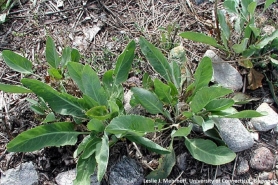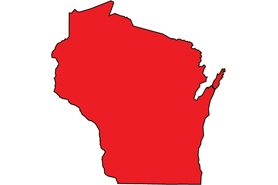Perennial pepperweed
(Lepidium latifolium)
An herbaceous, multi-stemmed perennial can reach five feet tall but remains a rosette for several weeks before bolting. Stems die back by late summer and the plan-ts have a horseradish taste and odor.
Other names for this plant include:
- Common names: tall whitetop, tall pepperweed, broadleaf pepperweed
- Scientific names: Cardaria latifolia
Classification in Wisconsin: Prohibited
- Ecological Threat
-
- A significant threat to coastal beaches and dunes, along with nearby grasslands where it forms dense stands.
- It can invade pastures, agricultural fields, riparian zones and disturbed areas.
- Identification
-
Leaves: Rosette leaves are up to 12 inches long with serrated margins and one to six-inch-long petioles. Cauline leaves are waxy, gray-green, and senesce as the top of the plant develops. Also, cauline leaves are alternate, sessile, elliptical and much smaller than basal leaves. They are tapered at the base and have weakly serrate margins.
Flowers: Small, white flowers form a dense cluster at the tops of the stems. Flowers have four small green sepals and four tiny petals.
Fruits & seeds: Each flower produces a two-chambered capsule with one flattened red-brown seed in each chamber.
Roots: Thick taproots can be up to six feet deep, form semi-woody crowns and have creeping rhizomes.
Similar species: Hoary cress (Cardaria draba; non-native) looks slightly like perennial pepperweed but is only up to three feet tall and leaves clasp the stem.
- Control
-
Mechanical: Not recommended due to the extensive root system. Continual mowing before the seed set may help suppress populations.
Chemical: Mowing or grazing in spring followed by foliar spray of chlorsulfuron or imazapyr. Foliar spray of glyphosate at flower bud stage on small populations.
For more information on control techniques, visit the Perennial pepperweed factsheet [exit DNR] by the University of Wisconsin-Extension.
- Resources
- Sources for content:
- Invasive Plant Atlas of New England: Perennial pepperweed [exit DNR].
- Plant Conservation Alliance, Alien Plant Working Group Fact Sheet: Perennial Pepperweed [exit DNR]. Last updated July 7, 2009.
- Renz, Mark. 2007. University of Wisconsin-System Board of Regents and University of Wisconsin-Extension, Cooperative Extension. Invasive plants of Wisconsin: Perennial pepperweed [exit DNR]. July 2007



